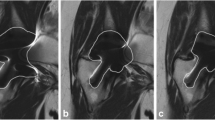Abstract
Purpose
This work aimed to compare the diagnostic performance of a metal artifact suppression sequence (MAVRIC-SL) for imaging of hip arthroplasties (HA) at 1.5 and 3 Tesla (T) field strength.
Methods
Eighteen patients (10 females; aged 27–74) with HA were examined at 3.0 and 1.5 T within 3 weeks. The sequence protocol included 3D-MAVRIC-SL PD (coronal), 3D-MAVRIC-SL STIR (axial), FSE T1, FSE PD and STIR sequences. Anatomical structures and pathological findings were assessed independently by two radiologists. Artifact extent and technical quality (image quality, fat saturation and geometric distortion) were also evaluated. Findings at 1.5 and 3.0 T were compared using a Wilcoxon signed rank test.
Results
While image quality was better at 1.5 T, visualization of anatomic structures and clinical abnormalities was not significantly different using the two field strengths (p > 0.05). Fat suppression and amount of artifacts were significantly better at 1.5 T (p < 0.01). Inter- and intra-reader agreement for different anatomic details, image quality and visualization of abnormalities ranged from k = 0.62 to k = 1.00.
Conclusion
MAVRIC-SL at 1.5 T had a comparable diagnostic performance when compared MAVRIC-SL at 3.0 T; however, the higher field strength was associated with larger artifacts, limited image quality and worse fat saturation.






Similar content being viewed by others
References
Shan L, Shan B, Graham D, Saxena A. Total hip replacement: a systematic review and meta-analysis on mid-term quality of life. Osteoarthr Cartil. 2014;22(3):389–406.
Singh JA. Epidemiology of knee and hip arthroplasty: a systematic review. Open Orthop J. 2011;5:80–5.
Kurtz S, Ong K, Lau E, Mowat F, Halpern M. Projections of primary and revision hip and knee arthroplasty in the United States from 2005 to 2030. J Bone Joint Surg Am Vol. 2007;89(4):780–5.
Iorio R, Healy WL, Warren PD, Appleby D. Lateral trochanteric pain following primary total hip arthroplasty. J Arthroplast. 2006;21(2):233–6.
Vicar AJ, Coleman CR. A comparison of the anterolateral, transtrochanteric, and posterior surgical approaches in primary total hip arthroplasty. Clin Orthop Relat Res. 1984;188:152–9.
Saito S, Ryu J, Oikawa H, Honda T. Clinical results of Harris-Galante total hip arthroplasty without cement: follow-up study of over five years. Bulletin. 1997;56(4):191–6.
Blankenbaker DG, Ullrick SR, Davis KW, De Smet AA, Haaland B, Fine JP. Correlation of MRI findings with clinical findings of trochanteric pain syndrome. Skelet Radiol. 2008;37(10):903–9.
Thomas MS, Wimhurst JA, Nolan JF, Toms AP. Imaging metal-on-metal hip replacements: the Norwich experience. HSS J. 2013;9(3):247–56.
Olsen RV, Munk PL, Lee MJ, Janzen DL, MacKay AL, Xiang QS, et al. Metal artifact reduction sequence: early clinical applications. Radiographics. 2000;20(3):699–712.
Lu W, Pauly KB, Gold GE, Pauly JM, Hargreaves BA. SEMAC: slice encoding for metal artifact correction in MRI. Magn Reson Med. 2009;62(1):66–76.
Koch KM, Lorbiecki JE, Hinks RS, King KF. A multispectral three-dimensional acquisition technique for imaging near metal implants. Magn Reson Med. 2009;61(2):381–90.
Koch KM, Brau AC, Chen W, Gold GE, Hargreaves BA, Koff M, et al. Imaging near metal with a MAVRIC-SEMAC hybrid. Magn Reson Med. 2011;65(1):71–82.
Kretzschmar M, Nardo L, Han MM, Heilmeier U, Sam C, Joseph GB, et al. Metal artefact suppression at 3 T MRI: comparison of MAVRIC-SL with conventional fast spin echo sequences in patients with hip joint arthroplasty. European Radiol. 2015.
Choi SJ, Koch KM, Hargreaves BA, Stevens KJ, Gold GE. Metal artifact reduction with MAVRIC SL at 3-T MRI in patients with hip arthroplasty. AJR Am J Roentgenol. 2015;204(1):140–7.
Liebl H, Heilmeier U, Lee S, Nardo L, Patsch J, Schuppert C, et al. In vitro assessment of knee MRI in the presence of metal implants comparing MAVRIC-SL and conventional fast spin echo sequences at 1.5 and 3 T field strength. J Magn Reson Imaging. 2014.
Yanny S, Cahir JG, Barker T, Wimhurst J, Nolan JF, Goodwin RW, et al. MRI of aseptic lymphocytic vasculitis-associated lesions in metal-on-metal hip replacements. AJR Am J Roentgenol. 2012;198(6):1394–402.
Lee YH, Lim D, Kim E, Kim S, Song HT, Suh JS. Usefulness of slice encoding for metal artifact correction (SEMAC) for reducing metallic artifacts in 3-T MRI. Magn Reson Imaging. 2013;31(5):703–6.
Garwood M, Ugurbil K, Rath AR, Bendall MR, Ross BD, Mitchell SL, et al. Magnetic resonance imaging with adiabatic pulses using a single surface coil for RF transmission and signal detection. Magn Reson Med. 1989;9(1):25–34.
Del Grande F, Santini F, Herzka DA, Aro MR, Dean CW, Gold GE, et al. Fat-suppression techniques for 3-T MR imaging of the musculoskeletal system. Radiographics. 2014;34(1):217–33.
Graf H, Steidle G, Martirosian P, Lauer UA, Schick F. Effects on MRI due to altered rf polarization near conductive implants or instruments. Med Phys. 2006;33(1):124–7.
Olsrud J, Latt J, Brockstedt S, Romner B, Bjorkman-Burtscher IM. Magnetic resonance imaging artifacts caused by aneurysm clips and shunt valves: dependence on field strength (1.5 and 3 T) and imaging parameters. J Magn Reson Imaging. 2005;22(3):433–7.
Farrelly C, Davarpanah A, Brennan SA, Sampson M, Eustace SJ. Imaging of soft tissues adjacent to orthopedic hardware: comparison of 3-T and 1.5-T MRI. AJR Am J Roentgenol. 2010;194(1):W60–4.
Grant support
We thank General Electric Healthcare for research funding and support. This research was in part funded with support from the National Institutes of Health (NIH). Grant numbers include U01 AR059507, R01 AR057336 and P50 AR060752.
Conflict of interest
All authors except for Dr. Michele Guindani have conflict of interests.
Author information
Authors and Affiliations
Corresponding author
Rights and permissions
About this article
Cite this article
Nardo, L., Han, M., Kretschmar, M. et al. Metal artifact suppression at the hip: diagnostic performance at 3.0 T versus 1.5 Tesla. Skeletal Radiol 44, 1609–1616 (2015). https://doi.org/10.1007/s00256-015-2214-5
Received:
Revised:
Accepted:
Published:
Issue Date:
DOI: https://doi.org/10.1007/s00256-015-2214-5




